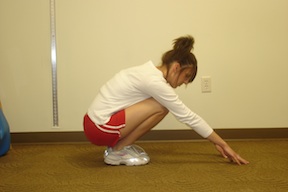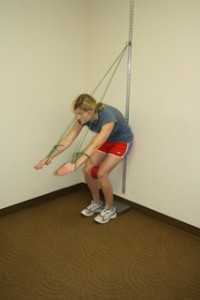By far, dysfunctional breathing mechanics drive most of the problems that my cyclist patients have. What I find is that the rib cage doesn’t move in the manner it’s supposed to or it is has poor structure (genetically, because of trauma, or because of years of habitual incorrect posture) to the point that breathing is stressed and inefficient. During cycling our demands for oxygenated air increase so much that we WILL find a way to get air in and out whether it’s through proper mechanics or not.
The cyclist, by nature of the position on the bike (regardless of discipline- road, mountain, or cyclocross; or set-up- standard or time trial) and because of the increase in cardiopulmonary demands (air), needs to be able to expand both the front and back of their chest wall efficiently. If they can’t they will compensate by overusing neck and back muscles or by improperly positioning their pelvis and hips. Performance may suffer due to diminished air exchange in the lungs.
The cycling position is actually a very nice position in a postural sense IF we have good breathing mechanics. But problems occur when there are restrictions in the back and front of the chest wall and an inability to expand on inhalation. Normal breathing mechanics call for expansion of both the belly and the chest on inhalation. In quiet, relaxed breathing we should be able to see both the belly and the chest rise and fall with each breath. If we round our backs and reach our arms forward (as if in the riding position) the front of the chest can’t expand as easily, so the back of the chest wall should expand and retract with each breath.
Competitive cyclists are sometimes taught to “breath from their diaphragm”. I see article after article and video after video describing that as maximally expanding the belly. That isn’t a proper description of diaphragmatic breathing. The diaphragm drops with each breath in and, yes, the belly should expand. But if we have a properly position positioned pelvis, spine, and rib cage, and, most importantly, decent abdominal muscle tone, the diaphragm will cause some belly expansion, but it will be held in check so that some of the expansion occurs through the front and back of the chest wall as well.
The rib cage has a high elastic component and is designed to expand and retract with each breath. So if we focus on just breathing into the belly, letting the abdominal muscles totally relax with each breath in, we will lose the elasticity of the rib cage over time and lock ourselves into a belly breathing pattern. This is a HUGE reason that a lot of people (not just cyclists) develop problems and have significant postural changes over time. We become so reliant on belly breathing that even relaxed breathing requires compensatory muscle use (neck and low back) and postural alterations. It only gets worse as time goes on and it makes getting into some positions, like on a bike, difficult and really stressed from a breathing perspective.
I’m going to do another post on how breathing problems are usually more asymmetrical in nature (most problems occur on one side more than the other) contributing to some of the typical one-sided problems that cyclists have, but for now I want to give just a couple examples of my favorite breathing exercises for cyclists. Both simulate (and slightly exaggerate) the position on the bike and demand chest wall expansion, abdominal tone, and a properly positioned pelvis. The hips, shoulder, head, and neck are all positioned roughly as if on a bike and emphasis is on avoiding compensatory use of neck and back muscles during inhalation.
We should be able to squat fully with shoes on. Feet and knees should be close together and you should be able to reach your arms forward. You should be able to breath fine and the expansion should be felt in the back of the chest wall. This signifies your ability to expand somewhere other than the belly. THIS is diaphragmatic breathing and means our diaphragm position is held in check by the roundness of the spine and the inability of the lower ribs to flare excessively. Spending some time in this position (even if you have to lightly hold onto something in front of you) and breathing into the back of the chest wall will help reduced the extraneous muscle activity in the neck, back, and hips that cyclist are prone to.

Photo courtesy of the Postural Restoration Institute®
Another is essentially the same but with added resistance to turn on the abdominals to ensure that lower rib flare is held in check. It’s done by attaching resistive tubing to the wall or door at shoulder level, standing close to a foot away from the wall with the hips hips resting on the wall. Squat and reach against the resistance of the tubing. Forward reach should come from rounding your back, not by hinging at the hips. A small ball or towel roll between your knees serves as a good reminder to keep knees moving inward rather than allowing outward hip rotation. You should feel your abs working. You should feel muscles around your shoulder blades working (these muscles actually help with expansion of the ribs). You can squat as deep as you want, with the head up in a position similar to that while on the bike.
Both of these techniques are great for gaining awareness of how to expand the back of your chest wall, because once you lose the ability to do this on a bike you’re much more prone to compensations that will cause a variety of strains leading to injury. They are great ones to do as a warm-up prior to riding or racing or when breathing feels restricted or back or neck muscles seem overactive and strained.
Stay tuned for Part 2 which will discuss how faulty asymmetrical breathing patterns lead to a variety of compensatory changes throughout the body.

